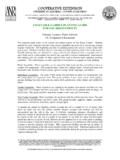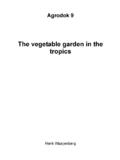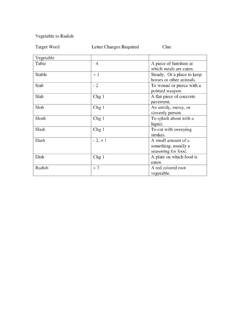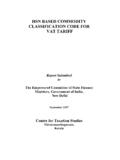Transcription of Vegetable planting guide updated 02.14.13 - UCCE San Diego ...
1 Vegetable GARDEN planting guide FOR SAN Diego COUNTY Vincent Lazaneo, Farm Advisor Emeritus UC Cooperative Extension This planting guide covers the coastal and inland regions of San Diego County. planting periods for some common cool and warm season vegetables are given for a year having average weather conditions. The beginning and end of a planting period can vary by several weeks from year to year. Gardeners need to exercise more judgment when planting early or late in the season. Suitable planting dates are dictated to a large extent by the amount of time a Vegetable takes to grow from seed to a harvestable size and by the Vegetable s climatic requirements. Seed packets and catalogs give the number of days required from seed to harvest under optimum growing conditions.
2 The cold tolerance of some vegetables is listed below as a guide for early planting . Hardy Vegetables: This group includes: cabbage plants (which have been well hardened), kale, kohlrabi, brussel sprouts, spinach, turnip, radish, asparagus, rhubarb and onion (from sets). These vegetables are not injured by light frosts and the seed will germinate at a rather low temperature. Half-Hardy Vegetables: This group includes: lettuce, beet, carrot, chard, parsley, parsnip, heading broccoli, early potatoes, onion (from seed), garden peas, celery plants, and cauliflower plants. The seeds of these vegetables will germinate at rather low temperatures, but the young plants are injured by frost.
3 Tender Vegetables: This group includes: snap bean, tomato, sweet corn, and sweet potato. These vegetables are injured by the lightest frost and do not thrive at a low temperature even when frost does not occur. They should not be planted until all danger of frost is past. Very Tender Vegetables: This group includes: eggplant, pepper, cucumber, watermelon, muskmelon, lima bean, squash, and pumpkin. These vegetables do not thrive until the soil has become warm. The seed will rot if the soil is not warm. To prepare a garden for planting , rototill or spade the soil to a depth of 8 to 12 inches, then break up clods and rake the surface level. Work soil when it is moist but not wet. Organic compost, manures and other amendments should be mixed into the soil at this time.
4 A pre-plant (starter) fertilizer should also be mixed into the soil prior to planting . Commercial fertilizers can be used alone or in combination with manures and compost to provide adequate soil fertility. If animal manures is used spread it evenly over the soil and thoroughly mix it into the top 6 inches of soil, 4-6 weeks before planting to avoid plant injury. For 100 square feet of area apply 20 pounds of composted poultry manure or 60 pounds of steer/dairy manure. Before planting , periodically water to leach harmful salts out of the surface soil. Mix commercial fertilizer containing nitrogen, phosphorus and potassium into the top six inches of soil just before planting at the rate recommended on the product label.
5 If a soluble chemical fertilizer was applied prior to planting , additional applications of a fertilizer containing only nitrogen are usually made periodically during the growing season to sustain vigorous plant growth. Apply nitrogen when seedlings are 3-4 inches tall, or about a month after setting out transplants. For 100 feet of row, evenly scatter 1 pound of ammonium sulfate (21% N) a few inches from the plants on each side of the row. Then water well with a sprinkler to dissolve and carry the fertilizer into the soil. The University of California prohibits discrimination against or harassment of any person on the basis of race, color, national origin, religion, sex, physical or mental disability, medical condition (cancer related or genetic characteristics), ancestry, marital status, age, sexual orientation, citizenship, or status as a covered veteran (special disabled veteran, Vietnam-era veteran or any other veteran who served on active duty during a war or in a campaign or expedition for which a campaign badge has been authorized).
6 University policy is intended to be consistent with the provisions of applicable State and Federal laws. Inquiries regarding the University s nondiscrimination policies may be directed to the Affirmative Action/Staff Personnel Services Director, University of California, Agriculture and Natural Resources, 300 Lakeside Drive, 6th Floor, Oakland CA 94612-3560. (510) 987-0096. University of California, County of San Diego , and the United States Department of Agriculture cooperating. 9335 Hazard Way, Suite 201 San Diego , CA 92123-1222 Office (858) 822-7711 Hortline (858) 822-6910 Fax (858) 822-7667 Most vegetables fall into two groups: Food value is generally higher per pound than in warm season crops planting time should allow the crop to mature during the cool season Root depth is shallow to medium Storage is at a cooler temperature and for a longer period than for warm season crops Store at 32 -42 F, except white potatoes (50 - 60 F) Food value is generally lower per pound than in cool season crops planting and harvesting time should be in the warm season.
7 Root depth is medium to deep Storage is at a warmer temperature and shorter period than for cool season crops Store tomatoes, garlic, onions and unripe melons at room temperature away from direct sunlight Store peppers, cucumbers, ripe melons, snap beans, summer squash at 45 -55 Note: Two exceptions to the above classifications are peas (a fruit, yet a cool season crop) and sweet potatoes (a root and warm season crop) We eat a vegetative part of the plant: Root carrot, parsnip, beet, radish, turnip Stem Kohlrabi, white potato Leaf spinach, lettuce, celery, asparagus, cabbage, onion Immature flower parts cauliflower, sprouting broccoli, globe artichoke COOL SEASON CROPS WARM SEASON CROPS We eat the fruit of the plant.
8 Mature fruit tomato, watermelon, cantaloupe, winter squash Immature fruit summer squash, cucumber, snap and lima beans, sweet corn Beans, Snap Mid Mar - Aug Beans, Snap Apr Mid Aug Beans, Lima Mid Apr - Jul Beans, Lima Mid Apr - Jul Cantaloupe Apr Jun Cantaloupe Apr Jun Corn, Sweet Mid Mar Jul Corn, Sweet Apr Jul Cucumbers Mid Mar Jul Cucumbers Apr Jul Eggplant (plants) Apr Jun Eggplant (plants) Apr Jun Melons (Casaba, etc) Apr Jun Melons (Casaba, etc) Apr Jun Okra Apr - Jun Okra Apr Jun Pepper (plants) Apr - Jul Pepper (plants) Apr - Jun Squash, summer Mid Mar - Aug Squash, summer Apr Jul Squash, winter Apr Jun Squash, winter Apr Jun Sweet Potato (plants) Apr Jun Sweet Potato (plants) May Jun Tomato (plants) Mar Jul Tomato (plants) Apr Jun Watermelons Apr Jun Watermelons Apr Jun Beets Sept - May Beets Sept Mid Apr Broccoli (plants) Sept - Feb Broccoli (plants) Sept Feb Broccoli (seeds) Aug - Dec Broccoli (seeds) Aug Oct Cabbage (plants) Sept - Feb Cabbage (plants) Sept Feb Cabbage (seeds)
9 Aug - Dec Cabbage (seeds) Aug Oct Carrots Sept - Apr Carrots Sept - Mar Cauliflower (plants) Sept - Feb Cauliflower (plants) Sept Feb Cauliflower (seeds) Aug - Dec Cauliflower (seeds) Aug Oct Chard Sept - Jun Chard Sept Apr Endive Sept - May Endive Sept Apr Kale Sept - Apr Kale Sept Apr Kohlrabi Sept - Mar Kohlrabi Sept Mar Head Lettuce Sept - Mar Head Lettuce Sept Feb Leaf Lettuce Sept - Apr Leaf Lettuce Sept Mar Onion (bulb) Onion (bulb) Short Day Oct - Dec Short Day Mid Oct Dec Medium Day Jan - Feb Medium Day Jan Feb Onion (green) Sept May Onions (green) Sept - Apr Peas Sept - Mar Peas Jan - Mar Potatoes (Irish) Feb Mar Mid Aug Sept Potatoes (Irish) Mid Feb - Apr Mid Aug Sept Radish Sept - May Radish Sept Mar Spinach Sept - Apr Spinach Sept Mar Turnips Sept - May Turnips Mid Sept Apr RECOMMENDED planting DATES Coastal Region (1&2) Warm Season Inland Region (3&4)
10 Warm Season Cool Season Cool Season SAN Diego COUNTY COASTAL AND INLAND Coastal Region Subdivisions 1 Maritime Zone Inland Zones 2 Hill & Mesa District 3 - Valley & Canyon District 4 High Elevation Zone BIOCLIMATE REGION Approximate Area = Sea Level to 2000 Elevation Contour Bioclimates are complexities of weather that differ from each other in some characteristic of importance to plants and animals. Subdivisions of California s bioclimates are named for the geographic areas with which they are most closely associated. These names are used to designate the agricultural areas of the state.








